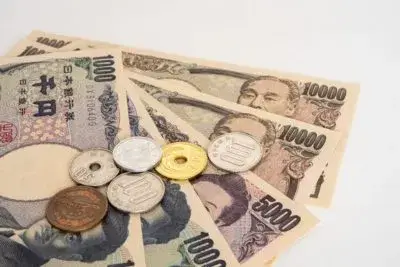The official currency of Japan is the Yen (currency symbol: ¥). Japanese money consists of 6 coins of ¥1, ¥5, ¥10, ¥50, ¥100, and ¥500. There are also 4 banknotes of ¥1000, ¥2000, ¥5000, and ¥10000 respectively. As in many countries, Japan’s money is illustrated with historically significant people and cultural symbols. Learn more about the people and places that are depicted on the money in Japan!


Japanese Coins
1 Yen aluminum coin
The design of the 1 yen coin was made in 1955, making it the oldest among Japanese coins. For the first time, the design of a coin had been decided by a public contest. The Wakagi tree that is drawn on the coin’s face is an imaginary tree and symbolizes the growth of Japan.
5 Yen brass coin
The current shape of the 5 yen coin has a hole in the center. It was designed in 1949 and the writing was renewed in 1959. The design of this coin represents the main Japanese industries of the time: the ear of rice = agriculture, water = fishery, the wheel = industry. In addition, the strand on the side of the coin symbolizes Japan’s parliamentary democracy following the defeat in WW2.
10 Yen bronze coin
The 10 yen coin was issued in 1959. The temple drawn on the coin is the Byodo-in Houou-do in Kyoto, classified as a UNESCO World Heritage Site. It was built by the clan of Fujiwara no Yorimichi, regent of the Heian period, in 1052. He had this temple built to create a paradise in this world. It has never been 100% destroyed despite the civil wars and two world wars. Therefore, it represents longevity and cultural richness.
50 Yen white copper coin
The first 50 yen coin was designed in 1955 and was made of silver. Its design had been decided with a public contest as for the 1 yen coin. The first version of the coin was undrilled and looked very similar to the 100 yen coin. Its design was modified in 1977 to be pierced when the 100 yen coin was renewed. On the front side, we can see chrysanthemums, a symbol of imperial power in Japan.
100 yen white copper coin
The first silver 100 yen coin came into circulation in 1957 with a phoenix in its design, and it was replaced in 1959 by the design of an ear of rice. As silver became more and more expensive, it was replaced by white copper in 1977 and at the same time, the design of the cherry blossom.
500 Yen brass and nickel coin
The 500 yen coin was introduced as the most recent and the most valuable coin. It was introduced in 1982 to be used in vending machines for drinks or subway tickets because they were developing very quickly and the prices were starting to rise. On the front side, there is a drawing of a paulownia, a sacred tree because the phoenix comes to rest on it. On the backside, there is a bamboo at the top and bottom and a tachibana, a Japanese citrus fruit, on the left and right. In 2000, its material was replaced by nickel and brass in order to fight against counterfeiting while keeping the same design.
Japanese Banknotes
If you look at Japanese paper money, you will see that historical figures are depicted on the bills. These faces should be familiar to Japanese people of any age because of their cultural value and not political value.
Bill of 1000 Yen
The current model was introduced in 2004. On the front is a portrait of Hideyo Noguchi (1876-1928), a bacteriologist who devoted himself to the study of yellow fever. On the back, Mount Fuji and the cherry blossom, both symbols of Japan, are drawn.
Bill of 2000 Yen
This quite rare bill was issued in 2000 to celebrate the G8 summit held on Okinawa Main Island in July of the same year. It is the only bill where no character portrait appears: on the front is drawn the Shurei-mon portal of Shuri Castle in Naha (Okinawa) and on the back, Murasaki Shikibu and his famous novel “The Tale of Genji”, written in the 11th century and considered as the first psychological novel in the world.
Bill of 5000 Yen
The current model was put into circulation in 2004 and this is the second time a woman appears on a banknote (the first being Empress Jingu in 1881). This woman is Ichiyo Higuchi (1872-1896), a poet of the Meiji era. On the reverse side, there is a painting of Iris by Korin Ogata (1658-1716).
Bill of 10000 Yen
The current model was put into circulation in 2004 along with the 1000 and 5000 yen banknotes. On the front, it shows the portrait of Yukichi Fukuzawa (1835-1901), a thinker, writer, teacher, translator who founded Keio University, and on the back, the phoenix of Byodo-in Hououdou Temple (sometimes referred to as the phoenix of the Golden Pavilion in Kyoto).
Your Japan Tour
As seasoned Japan experts, we can help you create your perfect Japan tour including guides that can tell you all about Japanese money, symbolism, and history. Contact us to start planning your unforgettable holiday to this fascinating country full of once-in-a-lifetime experiences, culture, history, nature, and delicious food!